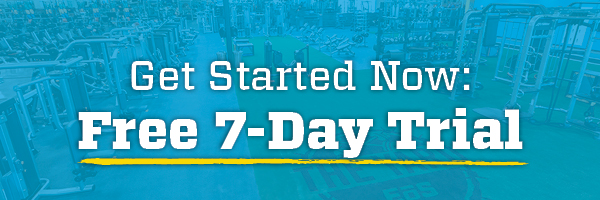If you’re looking to shed weight effectively and efficiently, you’ve come to the right place. Contrary to the belief that endless cardio is the only route to weight loss, multiple studies have shown how high-intensity interval training (HIIT) can significantly enhance weight loss efforts, offering a more time-efficient approach.
HIIT, a workout method alternating between brief, high-intensity exercises and rest or low-intensity periods, has quickly gained popularity. Its effectiveness and versatility make it ideal for all fitness levels, from beginners to pros.
In this blog, we’ll reveal how these short, dynamic workouts can be your biggest ally during your weight loss journey. So, lace up your sneakers, roll out your mat, and wave goodbye to the dread of endless cardio sessions.
What You Will Learn:
- Benefits of HIIT for Weight Loss
- Getting started with HIIT
- Top 10 HIIT Exercises for Weight Loss
- Beginner HIIT Workout
Estimated reading time: 5 minutes
Benefits of HIIT for Weight Loss
High-intensity interval training is more than just a fitness trend—it’s a scientifically backed method to enhance weight loss and overall health. Unlike traditional steady-state cardio workouts, HIIT challenges the body with intervals of intense exercise followed by periods of rest or low-intensity exercise.
HIIT can take on many forms, from Group Fitness Classes like cycling to circuit workouts at your gym or even in the comfort of your home. If you’re interested in getting started with HIIT, here are the key reasons why many turn to HIIT to reach their weight loss goals:
Boosts Your Metabolism
HIIT stands out as an effective weight loss method because it’s a powerhouse at torching calories, not just during but after your workout, too! By alternating between high-intensity bursts and rest periods, your body needs to work harder to recover, thus increasing your metabolic rate. This phenomenon, known as the afterburn effect or EPOC (excess post-exercise oxygen consumption), allows you to burn calories long after your workout.
Reduces Body Fat
The intense nature of the workout demands significant energy expenditure, which helps target fat loss, not just weight loss. This targeted approach ensures you burn fat while preserving muscle mass, sculpting a leaner, more toned physique.
Improves Cardiovascular Health
Looking for more workouts to improve your cardiovascular health? Check out these four heart-healthy exercises to do with a partner.
Getting Started with HIIT: What You Need to Know
Success in your HIIT sessions comes from more than just hard work during the workout; it’s also about how you plan, fuel and recover. Approaching these workouts with mindfulness and preparation is vital to ensure you set yourself up for success. Here are some tips to help you start your journey safely and effectively:
- Warm-Up is Non-Negotiable. A dynamic warm-up increases your heart rate, loosens up your muscles and prepares your body for the high demands of HIIT, significantly reducing the risk of injury. Spend 5-10 minutes on light aerobic exercises like jogging in place, jumping jacks or dynamic stretches to ensure your body is primed and ready. Learn more about the importance of warming up before exercising.
- Hydration is Key. Drinking plenty of water throughout the day, not just right before you exercise, is essential. During your workout, you’ll lose a lot of fluids through sweat, so remember to take small sips of water as needed during your workout. After finishing, rehydrate thoroughly to aid recovery. If you’re engaging in prolonged or particularly sweaty sessions, consider a sports drink with electrolytes to replenish what you’ve lost and prevent dehydration. Learn more about how hydration helps your fitness level.
- Nutrition Fuels Your Engine. What you eat before and after your HIIT workout can affect your performance. Pre-workout, focus on a light meal or snack that combines carbohydrates with a bit of protein; this could be a banana with peanut butter or a small smoothie. These nutrients provide a steady energy source and can help prevent muscle breakdown. Post-workout nutrition is about recovery. Aim for a meal or snack with a good mix of proteins and carbohydrates to repair muscles and replenish energy stores. A piece of grilled chicken with vegetables and quinoa or a protein shake with a blend of fruits are excellent choices.
- Consistency Over Intensity. Starting with 1 or 2 HIIT workouts per week allows your body to adapt to this new form of exercise without overwhelming it. As you build more endurance, you can increase the intensity or frequency of your workouts.
- Listen to Your Body. While pushing yourself is a part of HIIT, it is crucial to recognize the difference between pressing your limits and overstepping them. If you feel dizzy, nauseated or exhausted, take it as a sign to slow down or take a break. Listening to your body’s signals is essential for preventing burnout and injuries.
- Rest and Recover. A day or two of rest or lower-intensity activities like walking or yoga can help your body recover and prevent overuse injuries. Additionally, focus on getting plenty of sleep and managing stress, as these factors significantly impact your recovery and overall performance.
Top 10 HIIT Cardio Exercises for Effective Weight Loss
Whether you’re in the functional training area at your gym or working out at home, these HIIT cardio exercises are designed to be accessible, effective and adaptable to your needs.
Jumping Jacks
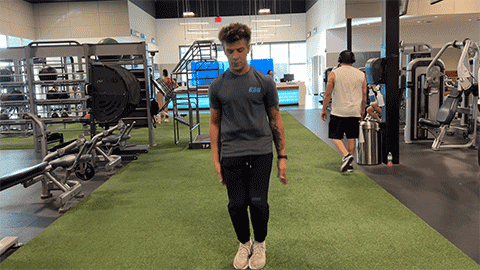
Start with your feet together and hands at your sides, then jump with your legs spread wide as you raise your arms overhead. Return to the starting position and repeat.
Modification: For a lower-impact version, in place of jumping, step one leg out to the side at a time while raising your arms overhead, then step back in and repeat with the other leg.
Squat Jumps
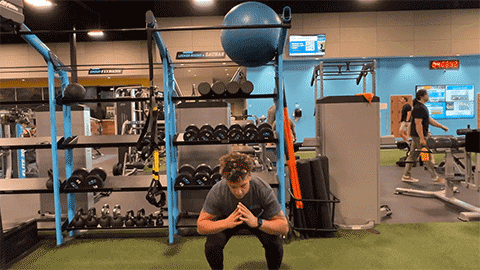
Begin with your feet shoulder-width apart. Sink into a squat position, ensuring your quads are parallel to the ground and your back is flat, not arched. From the bottom of the squat position, jump into the air and reach overhead, keeping your core tight and your tailbone tucked. Land back into the squat position gently, then repeat.
Modification: Instead of jumping, perform regular squats focusing on form and controlled movements to strengthen the lower body without the high impact on your knees and ankles. To add intensity without jumping, rise onto your toes at the top of the squat.
High Plank Hold
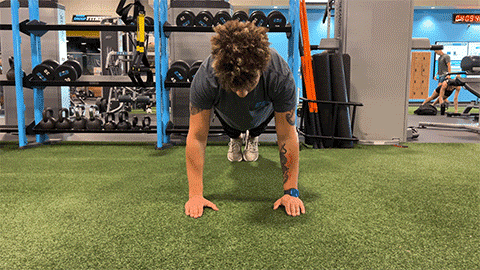
Start in a push-up position with your hands under your shoulders and your body forming a straight line from your head to your heels. Hold this position while maintaining a flat back to engage your core.
Modification: Try a forearm plank if a high plank puts too much pressure on your wrists or shoulders. This variation reduces strain on the wrists and shoulders while still engaging the core.
High Knees
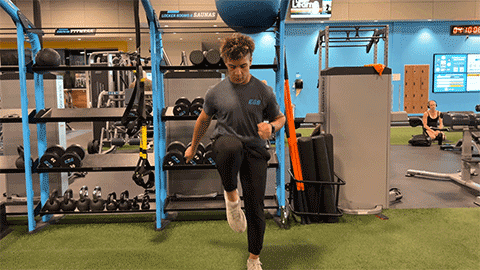
Start standing with your feet a width apart. Bring your knee to your chest one at a time while pumping your arms. Keep the pace fast and drive your knees up as high as possible.
Modification: March in place, lifting your knees as high as possible at a brisk pace to keep the intensity up without the high impact of running.
Mountain Climbers
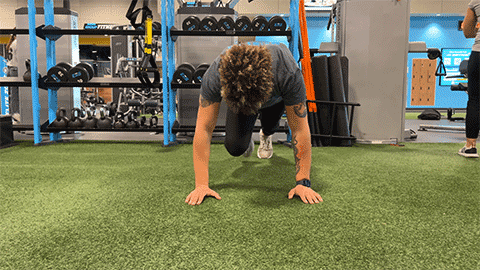
Start in a high plank position. Quickly draw one knee into your chest at a time, alternating at a fast speed while engaging your core.
Modification: For a lower-impact version, slow down the pace of the knee drives, focusing on form and engaging the core. You can also perform this exercise standing, pulling one knee towards the chest at a time, focusing on control and stability.
Reverse Lunges
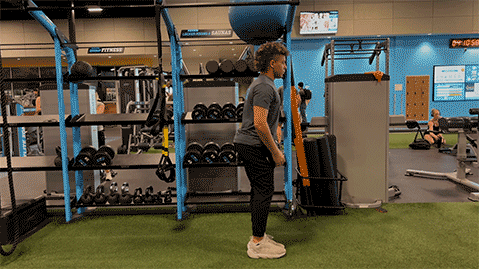
Stand with your feet hip-width apart with your hands by your chest or on your hips. Step backward with your right leg, slowly lowering your right knee below your right hip to form a 90-degree angle. Push your left foot into the ground, swing your right leg forward, back to the starting position and repeat on the other side.
Modification: Try a step-to-balance if reverse lunges are too challenging for your knees. Step forward with your right foot and balance on your right leg. Swing your left leg forward so both legs are parallel, but do not place your left foot on the ground. Hold the balance for 3-5 seconds before stepping back to the start and alternating legs.
Burpees
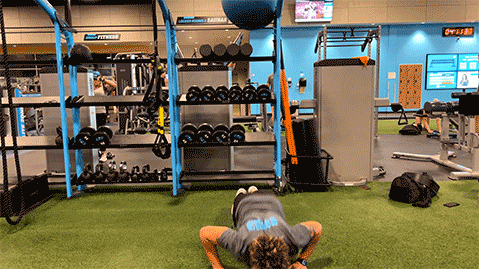
Start standing, then squat with your hands on the ground. Kick your feet back into a plank position, do a push-up, then move back into a squat position. Leap up as high as possible from the squat position.
Modification: Modify burpees by removing the jump and push-up. Step back into a plank position one foot at a time, hold for a moment, then step forward to return to standing.
Plank Shoulder Taps

In a high plank position, tap your left shoulder with your right hand and then your right shoulder with your left hand. Engaging your core muscles can help to prevent your hips from swaying.
Modification: Perform this exercise on your knees instead of your toes to reduce the intensity and provide more stability. Keep your hips stable and engage your core to maximize the benefits of this exercise.
Speed Skaters

Start standing, then leap to the left, landing on your left foot while sweeping your right foot behind you to the left, mimicking a speed skater’s movement. Repeat on the other side.
Modification: Instead of jumping from side to side, take a significant step to the side and cross your trailing leg behind you, tapping the floor for balance. Focus on a fluid side-to-side motion to maintain cardiovascular intensity.
Squat Jacks

Start in a squat position with your hands at your chest. Without standing up, jump your feet to the sides, immediately return to the starting squat position, and repeat.
Modification: For a less intense version, step out to the side into a squat one leg at a time, then step back to the center and repeat with the other leg.
10-minute cardio HIIT workout for beginners
Combine the exercises listed above for a dynamic 10-minute HIIT session. Perform each exercise for 30 seconds, followed by 15 seconds of rest, to keep the heart rate up and maximize calorie burn. Repeat the circuit or lengthen the intervals for an extended session as your endurance improves.
- Warm-up: Spend 3-5 minutes on quick and easy cardio warm-up exercises, such as bodyweight squats, arm circles, or butt kickers.
- Jumping Jacks (30 seconds on, 15 seconds rest)
- Squat Jumps (30 seconds on, 15 seconds rest)
- High Plank Hold (30 seconds on, 15 seconds rest)
- High Knees (30 seconds on, 15 seconds rest)
- Mountain Climbers (30 seconds on)
- 30-second water break
- Reverse Lunges (30 seconds on, 15 seconds rest)
- Burpees (30 seconds on, 15 seconds rest)
- Plank Shoulder Taps (30 seconds on, 15 seconds rest)
- Speed Skaters (30 seconds on, 15 seconds rest)
- Squat Jacks (30 seconds on)
- Cool-Down: Dedicate 3-5 minutes after your HIIT session for some static stretches to facilitate recovery.
Incorporating HIIT into Your Routine at EōS Fitness
Ready to take your fitness to the next level with HIIT? EōS Fitness offers a supportive and dynamic environment for anyone looking to start or enhance their weight loss journey. Whether working out in The EōS Yard® functional training area or attending one of our HIIT, you will find the motivation and challenge you need. Sign up today for a FREE 7-Day Pass and experience the difference a supportive fitness community can make in reaching your fitness goals.


